- 1Inter University Accelerator Centre, New Delhi, India
- 2Jam. Co-operative College, Kolhan University, Chaibasa, Jharkhand, India
- 3Chemical Sciences Division, Lawrence Berkeley National Laboratory, Berkeley, CA, United States
- 4Punjabi University, Patiala, Punjab, India
We have investigated the effect of the target atomic number Z2 on the mean charge state (
1 Introduction
The interaction of highly charged ions with media particles through gaseous, solid, and plasma targets has been the subject of extensive study for understanding fundamental problems in atomic and nuclear physics, plasma physics, accelerator physics, and various applications in semiconductor technology [1–5]. These interactions are complex due to the simultaneous occurrence of various physical processes, such as ionization, excitation, radiative decay, Auger decay, electron decay, and radiative and non-radiative electron capture. Several studies have been conducted to shed light on these interactions [6–9]. These studies provide theoretical frameworks, experimental techniques, and data collected up to the time of publication. When highly charged ions (HCIs) penetrate through targets (gaseous or solid), they interact with the target atoms and produce a charge state distribution (CSD). To replicate the mean charge state (
In this work, only the models that demonstrate a dependency of the mean charge state (
Currently, there are computer programs such as ETACHA [19], GLOBAL and CHARGE [20], and BREIT [21] that can calculate the charge state fractions as the ion beam moves through solid and gaseous targets [22, 23]. A new version of ETACHA, called ETACHA4, has recently been developed, [24] and it can now handle lower energies (0.05–30 MeV/u) and ions with up to 60 electrons. Additionally, the equilibrium mean charge state can now be measured using X-ray spectroscopy [25].
We have compared the predictions of empirical models such as Z-B-L and F-G-M; semi-empirical models including S-I-M, Schiwietz model, and S-G-M; and the theoretical model ETACHA4 for the dependence of the mean charge state (
2 General background
When an ion beam passes through a target with the thickness x (atoms/cm2), various electron capture and loss processes (radiative and non-radiative electron capture, ionization, electron emission, excitation to bound states, etc.) become effective, and for increasing target thickness, the charge state fractions
The dependence of the
where x is the target thickness or the areal density. The sum over q means the summation of cross-sections over all possible charge states:
For a given equilibrium charge state distribution, the equilibrium mean charge state
The distribution of equilibrium fractions
and the asymmetry parameter s (skewness) is defined as
3 Empirical and semi-empirical models
We shall briefly discuss different empirical and semi-empirical models and ETACHA4 for the equilibrium mean charge state
3.1 Shima–Ishihara–Mikumo model
The Shima–Ishihara–Mikumo model [15] has refined the equilibrium mean charge state
where
Here
The authors cite the limitations of their target-dependent model as
3.2 Ziegler–Biersack–Littmark model
The Ziegler–Biersack–Littmark model is used in the well-known Stopping and Range of Ions in Matter (SRIM) code [11]. The Z-B-L formula can be written as:
where
where v is the ion velocity and
3.3 Schiwietz model
Schiwietz et al. [17] have used a large array of over 800 data points that span a wide variety of ions and aims to determine the equilibrium mean charge state
Here, Z is the atomic number of the ion,
is a reformulated reduced velocity, and the power term is used to adjust the steepness of the charge state curves as a function of x with the following correction terms:
and
where
where
3.4 Schiwietz–Grande model
The Schiwietz–Grande model (S-G-M) [16] has presented a highly parameterized least-squares fit built from an array of over 850 experimental data points for the equilibrium mean charge state
where
3.5 Fermi-gas model
According to the Fermi-gas model (F-G-M)-based empirical formula, the mean charge state
with
4 Results and discussion
We have conducted a comparison between the predictions of empirical, semi-empirical, and theoretical models (ETACHA4) for the dependence of the equilibrium mean charge state
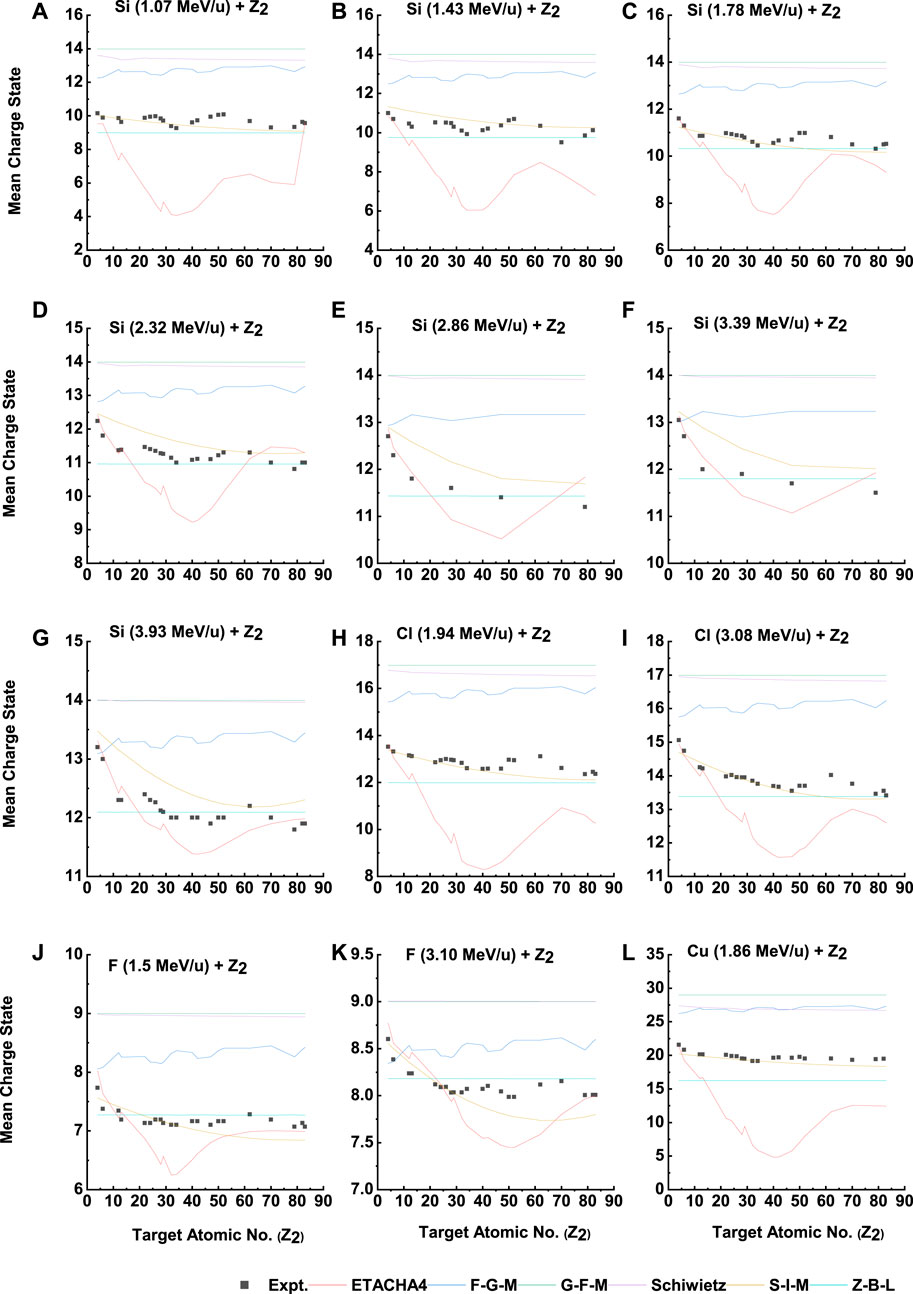
FIGURE 1. The equilibrium mean charge state vs. target atomic number for Si (A–G), Cl (H, I), F (J, K), and Cu (L) projectiles at different energies. Experimental data are taken from Ref. 26. The solid lines are provided only to guide the eye.
The oscillation in the mean charge state
In contrast, at lower energies, the inner shell electron contributes less to the excitation and ionization, which can be inferred from Coulombic repulsion dominating at the exit surface of the target.
The Z-B-L empirical model demonstrates a weak dependence between the mean charge state
In the F-G-M model, the predictions for the mean charge state
In the Schiwietz model, there is a considerable gap (5.85–7.77) between the experimental results and the model’s predictions for all four projectile ions across the range of target atomic numbers. The model overestimates the experimental results, but as the beam energy increases, the agreement improves gradually. This significant mismatch at low energies can be attributed to the model’s failure to properly account for excitation and ionization effects.
The S-I-M model predicts a monotonic decrease in the mean charge state
The F-G-M model reveals an oscillatory pattern in the mean charge state
Further, the ETACHA4 model does not show oscillatory behavior in
The atomic numbers of the target and the projectile are represented by
Comparing the values of Kp parameters for different targets, we see that the values are less than 1 for Be, C, Mg, and Al targets throughout the energy range. One expects good agreement between the theory and experiment. The Kp parameter is greater than 1 for other targets throughout the energy range, and thus, the agreement between the theory and experiment may be worse, as evident from the figure. However, the departure is much higher in intermediate
In addition, for a quantitative evaluation of the model predictions, we have calculated the sum of the squared residuals (SSR),
where
to find the minimum mean errors
In summary, the detailed comparison suggests that predictions from the S-I-M and Z-B-L models are somewhat superior to those from the other models. The mean charge state
4.1 Effect of Fermi velocity
The Fermi velocity
4.1.1 Z-B-L model
As discussed previously, the prediction of the Z-B-L model is closer to the experimental data. Apart from fluorine, for all projectiles (Si, Cl, and Cu), the predictions underestimate the experimental data, as shown in Figure 2. However, Z-B-L predictions show an oscillatory nature similar to that of the experimental results. Figure 3 shows the percentage deviation between Z-B-L predictions and experimental data. In Figure 4, we have shown
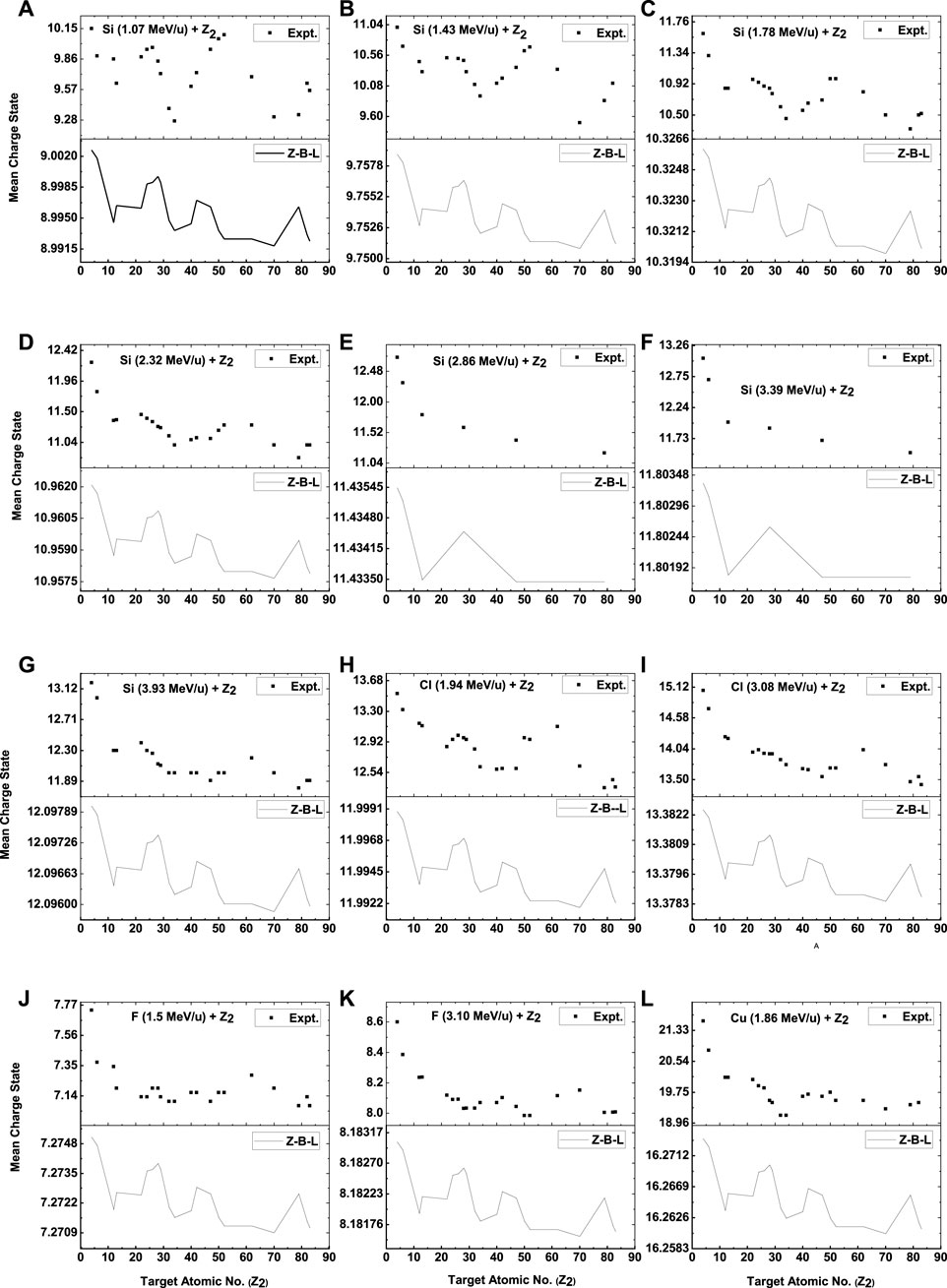
FIGURE 2. Comparison of experimental mean charge state
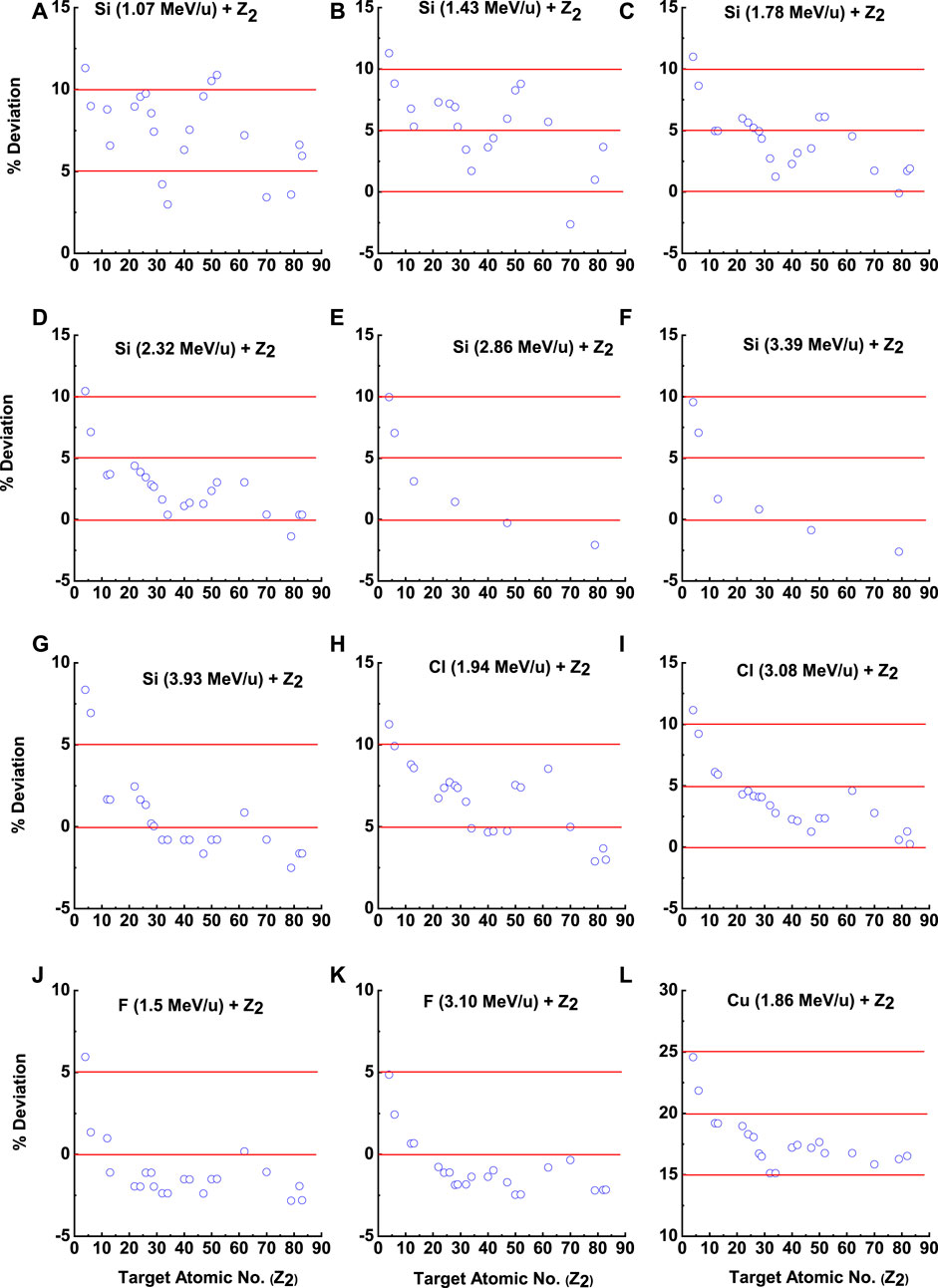
FIGURE 3. Comparison of the percentage of deviation of the Z-B-L model and the experimental mean charge state
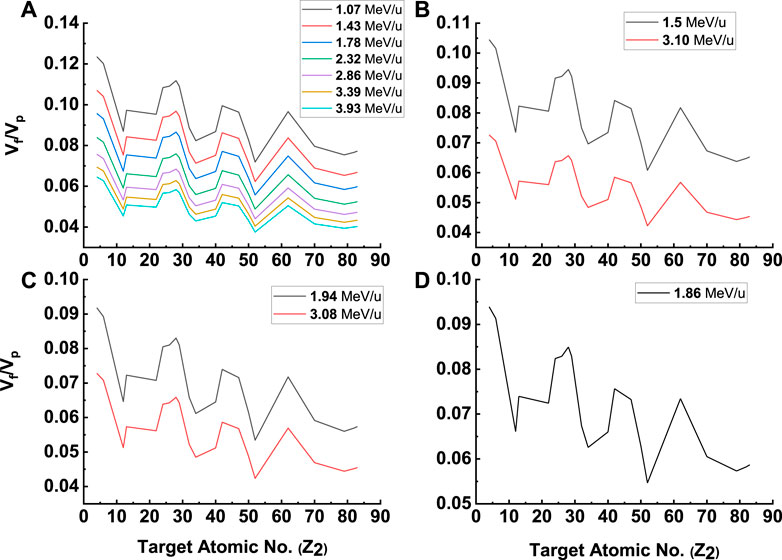
FIGURE 4. Z2 dependence of Fermi velocities with respect to projectile velocities: (A) Si as projectile, (B) F as projectile, (C) Cl as projectile, and (D) Cu projectile.
The Fermi velocity is a measure of how quickly electrons can move within a material and is related to its electronic properties, such as electrical conductivity. The Fermi velocity is an important parameter in the calculation of various properties of solids and is also used in the description of electron–phonon interactions and transport phenomena in materials.
As can be seen from Figure 4, the oscillation strength is stronger for low Z targets. As the target atomic number increases, the strength of the oscillation decreases noticeably. This is a clear demonstration of the effect of the target’s electronic structure, as higher Z targets have more electrons compared to low Z target systems.
4.1.2 F-G-M model
Figure 5 shows a comparison between experimental data and theoretical results from the F-G-M model for the mean charge state
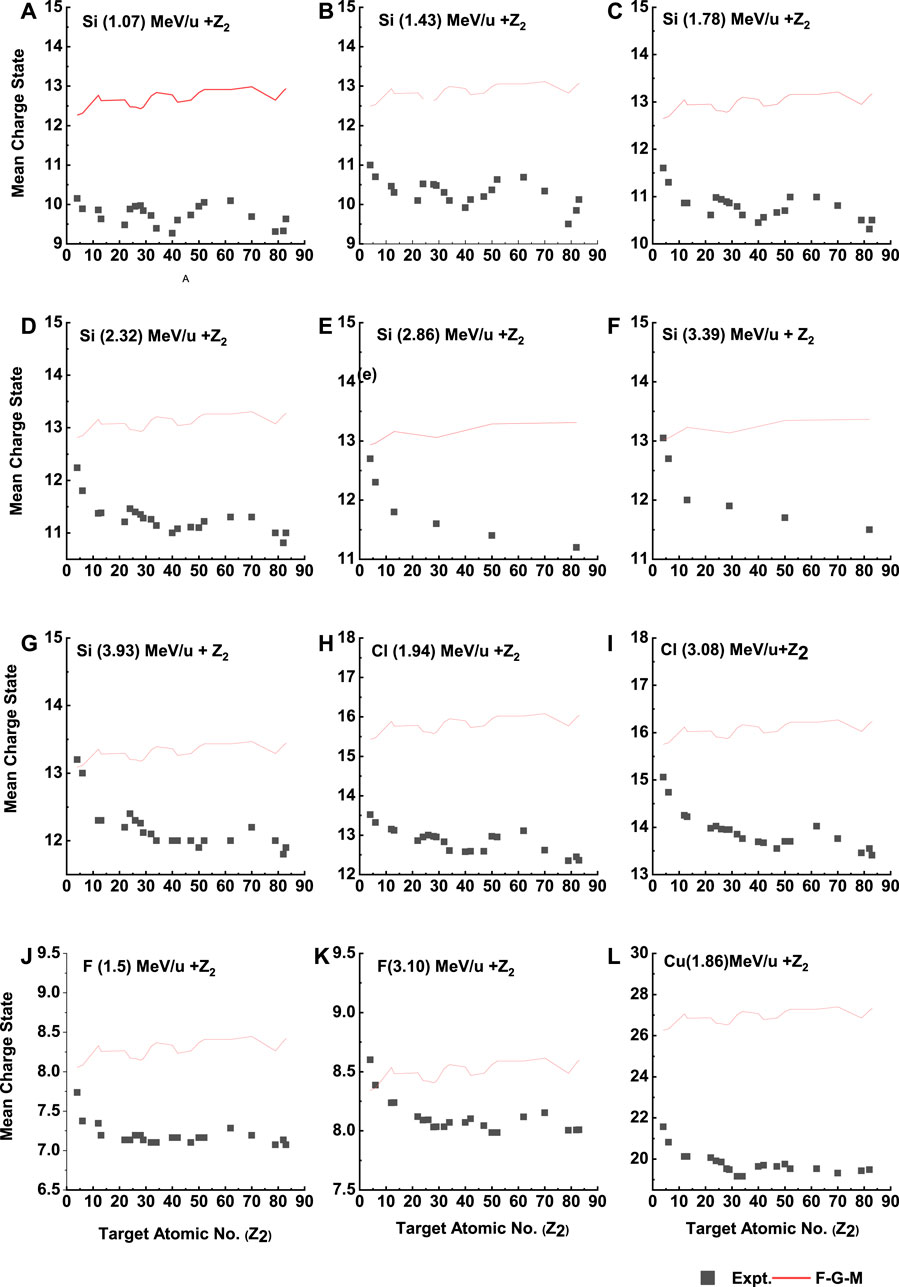
FIGURE 5. Comparison of experimental mean charge state
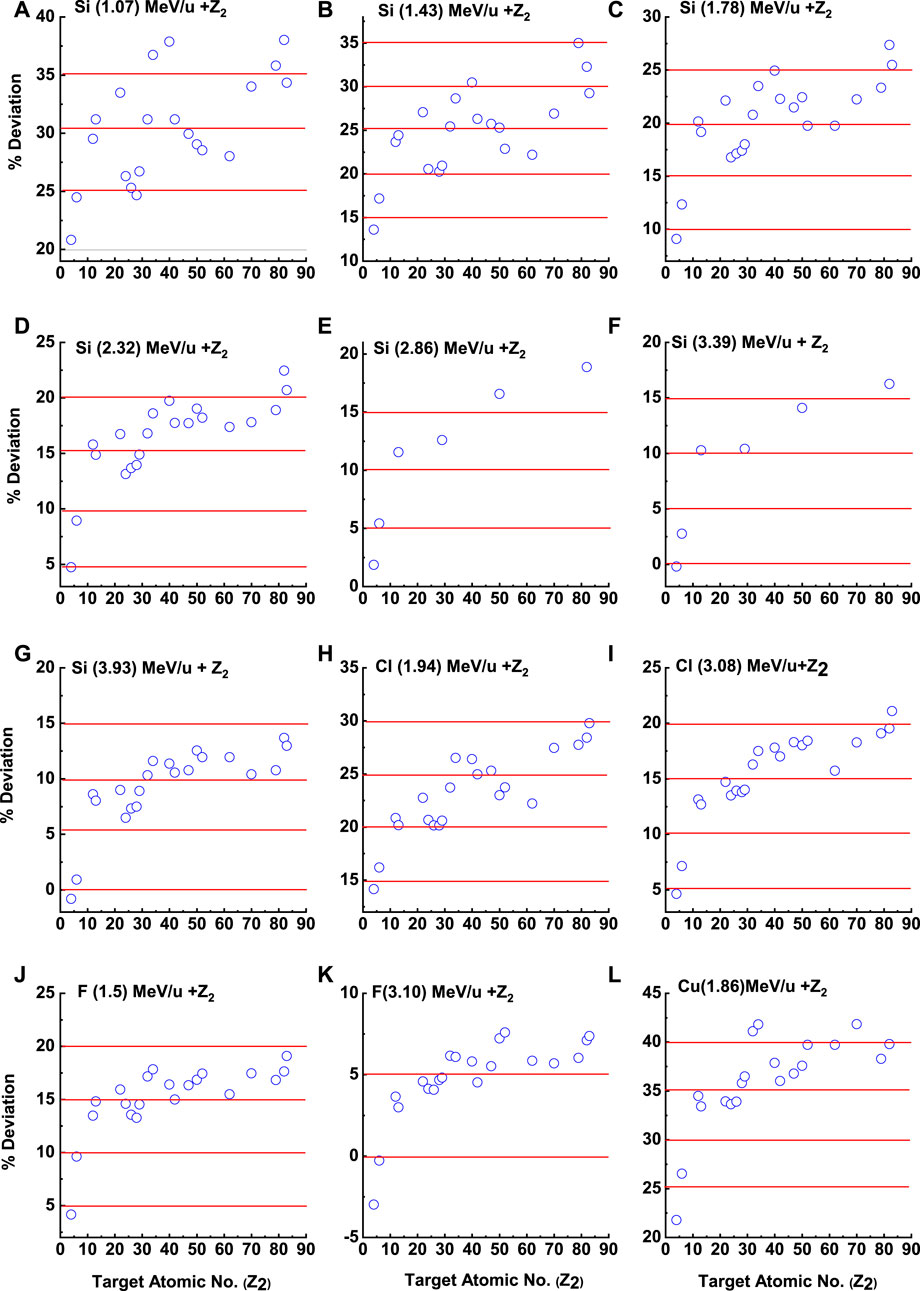
FIGURE 6. Comparison of the percentage of deviation of the F-G-M model and the experimental mean charge state
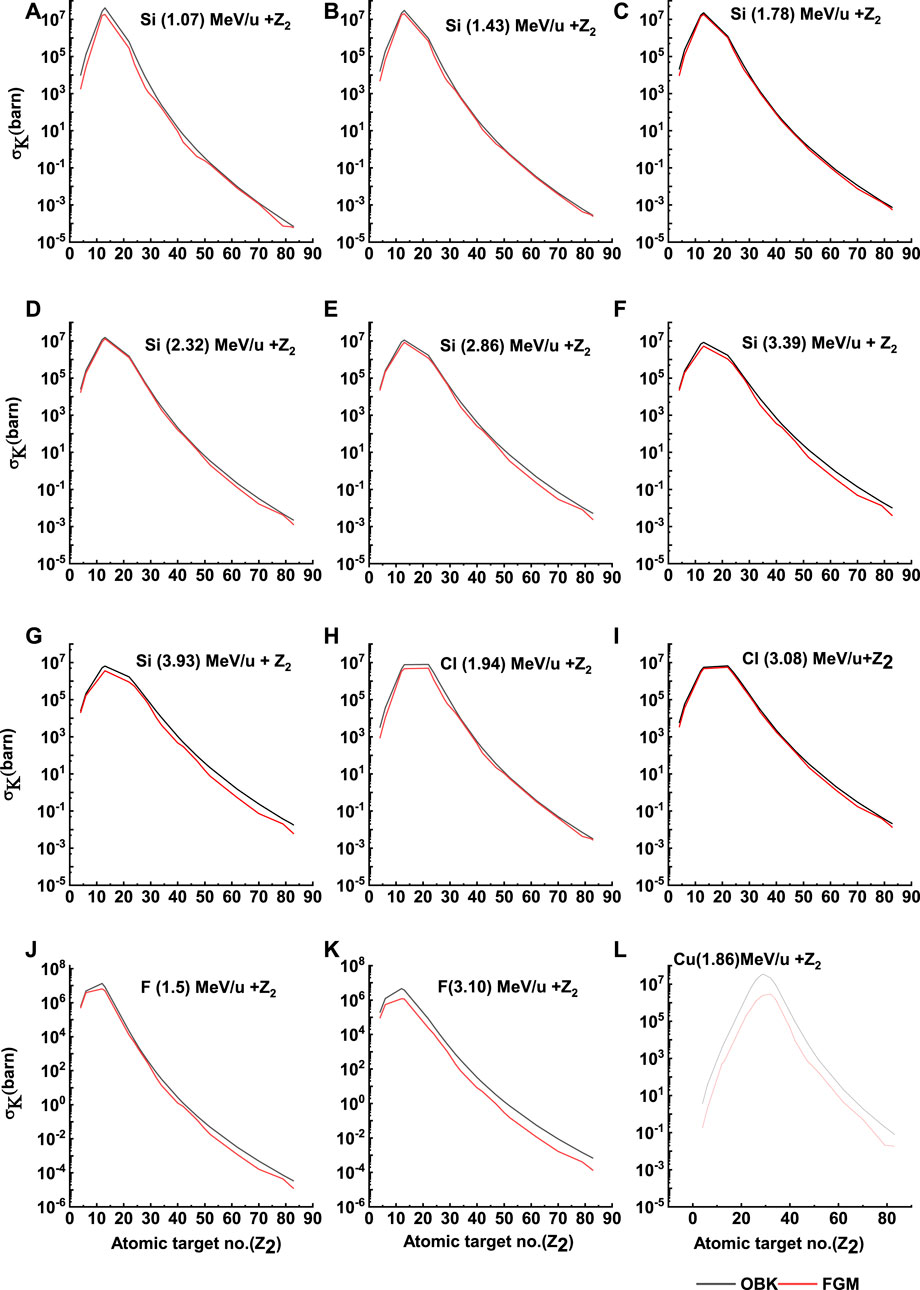
FIGURE 7. The electron capture cross sections obtained from OBK approximation and F-G-M prediction vs target atomic number (Z2) bombarded by H-like Si (A-G), Cl (H, I), F (J, K), and Cu (L) ion beam. The solid lines are to guide the eye only.
4.2 Effect of electron capture at the exit surface
Apart from the electron capture processes occurring inside the target, certain electron capture processes also occur at the exit surface of the target [28–32], including the radiative and non-radiative capture processes. In addition, the surface electron capture processes must change every charge state produced inside the target. Consequently, the mean charge state shifts to a lower charge state. This effect is more prominent on the low-energy side as the electron capture cross-section is higher at low beam velocities [28]. The F-G-M data in Figure 5 reflect this exact picture, i.e., the predictions are higher than the measured values. F-G-M
Furthermore, the difference in mean charge state between the experimental findings and the F-G-M model shown in Figure 5 goes even up to 3. Such a scenario favors the multi-electron capture process occurring at the exit surface of the target.
The underestimation of experimental data by the F-G-M model predictions shows that the surface electron capture processes must alter every charge state produced inside the target. To understand the deviation between experimental data [26] and F-G-M predictions, an electron capture phenomenon (electron capture cross section) is calculated. To obtain the electron capture cross-section from inner shells by fully stripped ions, the theory of Lapicki and Losonsky [33] has been used, which is based on the Oppenheimer–Brinkman–Kramers (OBK) approximation [34] with binding and Coulomb deflection correction for low-velocity ions. Thus, we have made use of Nikolaev’s electron capture cross-section [35] formula.
and
Calculations for the electron capture cross section in Figures 4, 5 are based on the OBK approximation [34] and the F-G-M model [18] for H-like Si ions. The effective electron capture cross-section from the F-G-M model is equal to
Here, the distribution width
Here,
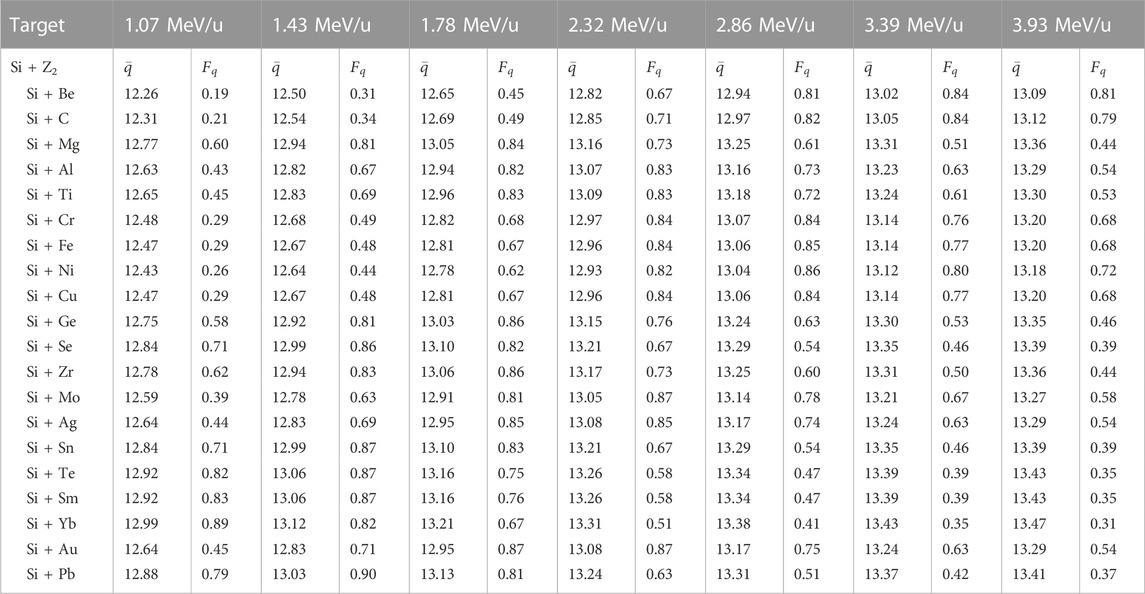
TABLE 1. Charge state fraction of H-like Si (Si+13) obtained from F-G-M [18] in different target elements and at different kinetic energies of the Si ion beam.
Figure 7 shows a comparison between the electron capture cross-sections obtained from OBK approximations and F-G-M predictions, where the targets vary but the beam energy is fixed. As the target atomic number increases, a considerable difference occurs between the F-G-M predictions and the OBK approximation. However, F-G-M predictions underestimate the OBK approximation. For fixed ion beam energy, when the target atomic number increased, the electron capture cross-section increased. But, after a certain target atomic number, the electron capture cross-section decreased with increasing target atomic numbers. In Figure 7, we can see that, when
In Figures 8, 9, the electron capture cross-sections were obtained from OBK approximation and F-G-M prediction for different targets bombarded by Si28 ions as a function of ion beam energies. Here, the electron capture cross-sections obtained from the F-G-M model predictions underestimate the OBK approximation. For low atomic numbers 4–6 and high atomic numbers 22–83, the electron capture cross-section increased with increasing beam energy for the asymmetric collision partners (
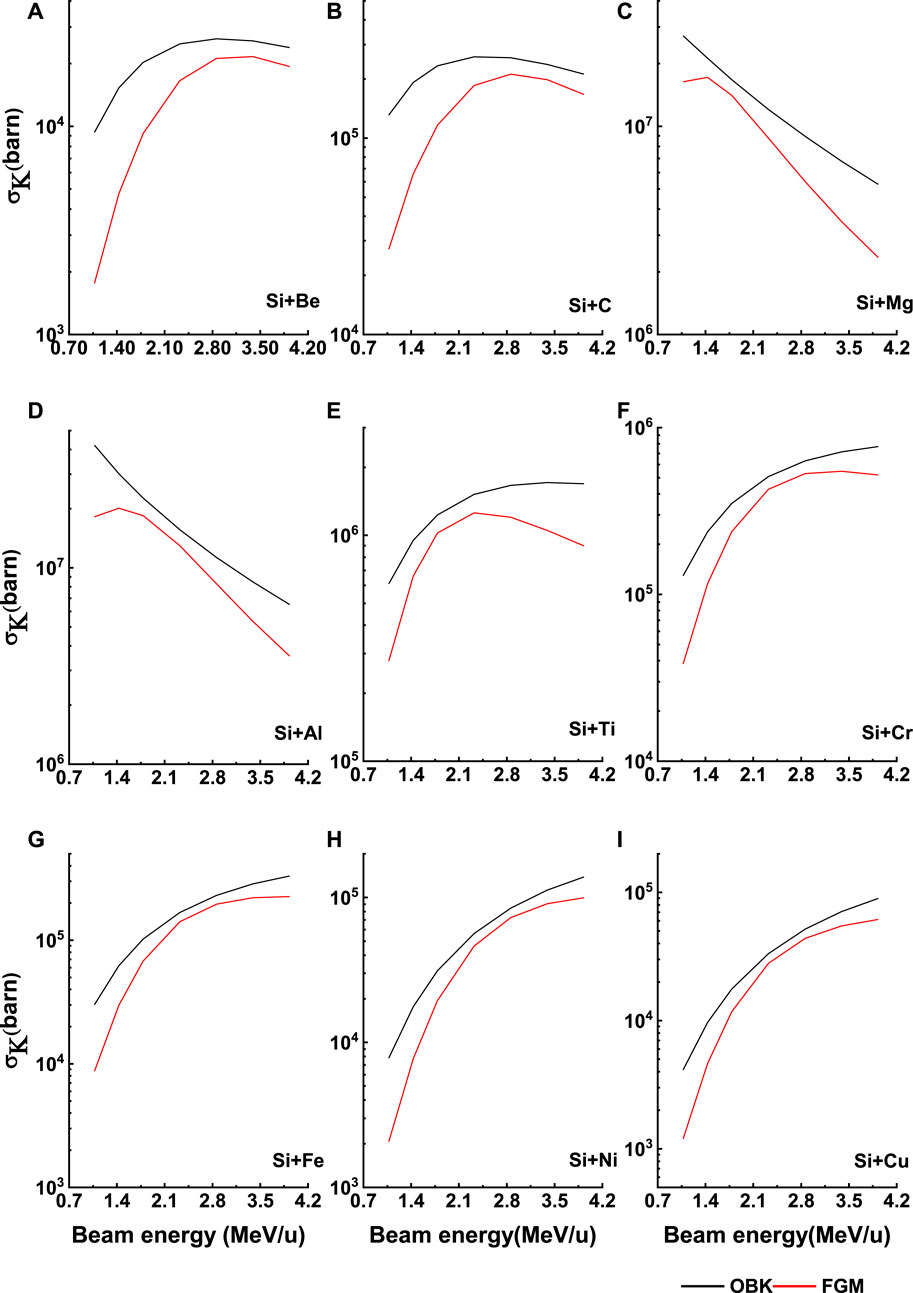
FIGURE 8. The electron capture cross sections obtained from OBK approximation and F-G-M prediction for different targets (from Be to Cu) bombarded by Si28 ions as a function of ion beam energies (A-I). The solid lines are to guide the eye only.
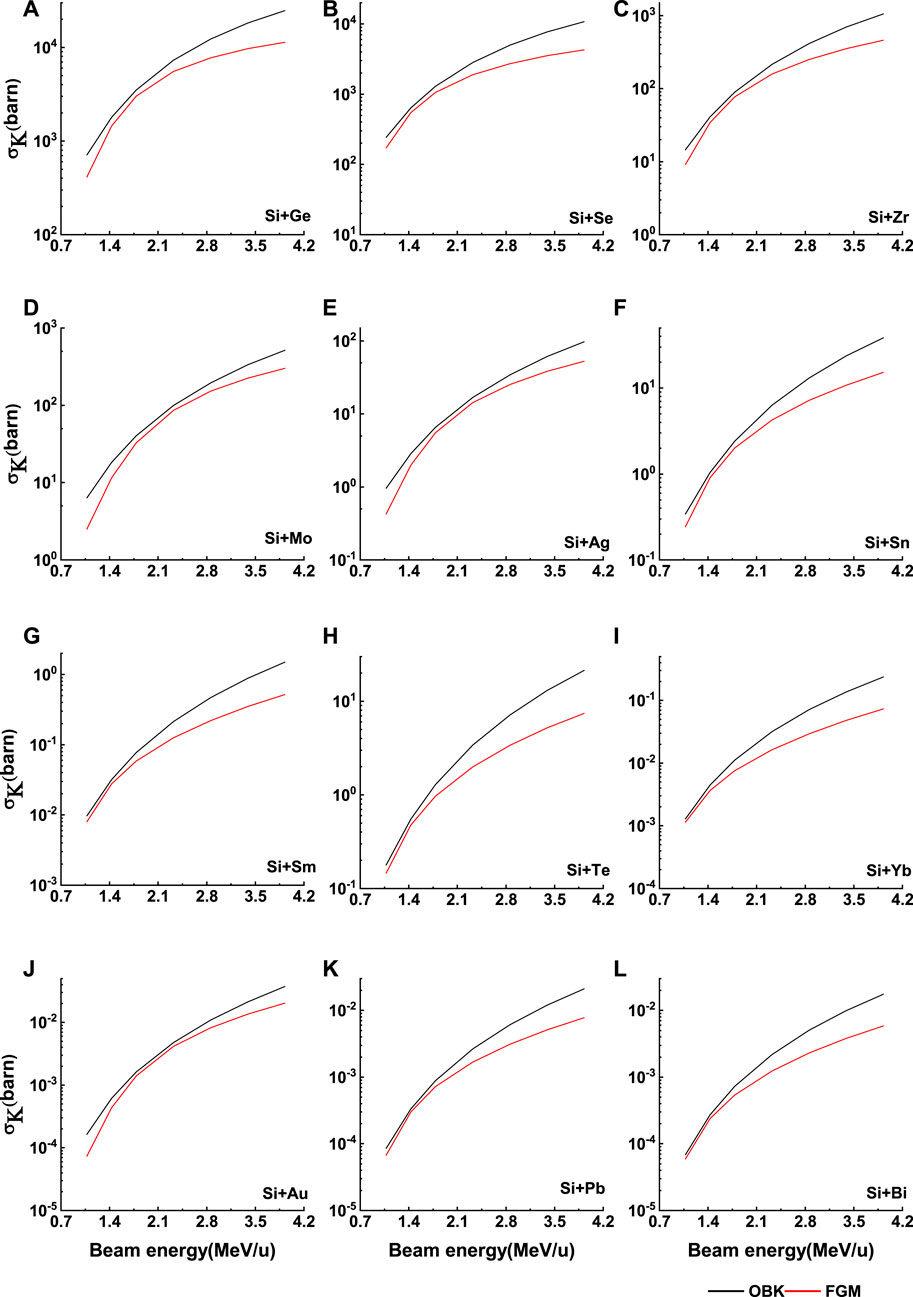
FIGURE 9. The electron capture cross sections obtained from OBK approximation and F-G-M prediction for different targets (from Ge to Bi) bombarded by Si28 ions as a function of ion beam energies (A-L). The solid lines are to guide the eye only.
It is clear from the aforementioned scenario that the electromagnetic measurements, magnetic or electric, cannot map the actual picture occurring in the bulk of the foil as it concerns the total charge of the ion. The total charge is governed by both bulk and surface effects.
5 Conclusion
Drawing a thorough comparison with the experimental values, empirical models show a trend similar to that of the experimental results. After scrutinizing the F-G-M and Z-B-L models (both empirical) in terms of Fermi velocity
For further study on the electron capture cross-section for different targets with different energies of the projectile, we observed that the electron capture cross-section from the OBK approximation differs from the electron capture cross-section from the F-G-M model prediction. The F-G-M model predictions underestimate the OBK approximation. Therefore, electron capture cross-sections from within and at the exit surface of the target are required to resolve this difference. In this context, a projectile’s mean charge state post-collision with the target is extremely essential. Furthermore, the study about the influence of the target atomic number (Z2) on mean charge state can enhance our understanding of the target density effect in bulk media.
Data availability statement
The original contributions presented in the study are included in the article/supplementary material; further inquiries can be directed to the corresponding authors.
Author contributions
DK wrote the original draft of the manuscript. SK and BS revised the manuscript. RK supervised the manuscript preparation. All authors contributed to the article and approved the submitted version.
Acknowledgments
DK acknowledges discussion and support from ATMOL group at IUAC, New Delhi.
Conflict of interest
The authors declare that the research was conducted in the absence of any commercial or financial relationships that could be construed as a potential conflict of interest.
Publisher’s note
All claims expressed in this article are solely those of the authors and do not necessarily represent those of their affiliated organizations, or those of the publisher, the editors, and the reviewers. Any product that may be evaluated in this article, or claim that may be made by its manufacturer, is not guaranteed or endorsed by the publisher.
References
1. Alison SK, Warshaw SD. Passage of heavy particles through matter. Rev Mod Phys (1953) 25:779–817. doi:10.1103/revmodphys.25.779
2. Alison SK. Experimental results on charge-changing collisions of hydrogen and helium atoms and ions at kinetic energies above 0.2 kev. Rev Mod Phys (1958) 30:1137–68. doi:10.1103/revmodphys.30.1137
3. Betz HD. Charge states and charge-changing cross sections of fast heavy ions penetrating through gaseous and solid media. Rev Mod Phys (1972) 44:465–539. doi:10.1103/revmodphys.44.465
4. Schardt D, Elsasser T, Schulz-Ertner D. Heavy-ion tumor therapy: Physical and radiobiological benefits. Rev Mod Phys (2010) 82:383–425. doi:10.1103/revmodphys.82.383
5. Nikoghosyan A, Schulz-Ertner D, Didinger B, Jakel O, Zuna I, Hoss A, et al. Evaluation of therapeutic potential of heavy ion therapy for patients with locally advanced prostate cancer. Int J Radiat Oncol Biol. Phys. (2004) 58:89–97. doi:10.1016/s0360-3016(03)01439-1
6. Betz H. D. Charge Equilibration of High-Velocity Ions in Matter. Methods Exp Phys (1980) 17:73-148. doi:10.1016/S0076-695X(08)60298-7
7. Shima K, Ishihara T, Miyoshi T, Mikumo T. Equilibrium charge-state distributions of 35—146-MeV Cu ions behind carbon foils. Phys Rev A (1983) 28:2162–8. doi:10.1103/physreva.28.2162
8. Shima K, Mikumo T, Tawara H. Equilibrium charge state distributions of ions (Z1 ⩾ 4) after passage through foils: Compilation of data after 1972. Data Nucl Data Tables (1986) 34:357–91. doi:10.1016/0092-640x(86)90010-0
9. Shima K, Kuno N, Yamanouchi M, Tawara M. Equilibrium charge fractions of ions of Z = 4–92 emerging from a carbon foil. Data Nucl Data Tables (1992) 51:173–241. doi:10.1016/0092-640x(92)90001-x
10. Woodgate GK. Elementary atomic structure. Clarendon Press, Oxford, New York and Oxford Science Publications (1983).
11. Schmitt C. J. (2010). Equilibrium charge state distributions of low-z ions incident on thin self-supporting foils. Graduate School of the University of Notre Dame, Indiana and Christopher J. Schmitt.
12. Nikolaev V. S., Dmitriev I. S. (1968). On the equilibrium charge distribution in heavy element ion beams. Phys. Lett. 28A:277–278. doi:10.1016/0375-9601(68)90282-X
13. To K. X., Drouin R. Equilibrium-charge-state distribution studies of energetic boron ions in carbon and observation of doubly excited states in B III. Physics Scripta (1976) 14:277-280. doi:10.1088/0031-8949/14/6/006
14. To K. X., Drouin R. Semi-empirical determination of the charge states of a fast ion beam (Z<=18). Nucl. Instr. And Meth. (1978) 160:461-463. doi:10.1016/0029-554X(79)90201-5
15. Shima K, Ishihara T, Mikumo T. Empirical formula for the average equilibrium charge-state of heavy ions behind various foils. Nucl Instr Meth (1982) 200:605–8. doi:10.1016/0167-5087(82)90493-8
16. Schiwietz G, Grande PL. Improved charge-state formulas. Nucl Instr Meth Phys Res B (2001) 175:125–31. doi:10.1016/s0168-583x(00)00583-8
17. Schiwietz G, Czerski K, Roth M, Staufenbiel F, Grande PL. Femtosecond dynamics – snapshots of the early ion-track evolution. Nucl Instr Meth Phys Res B (2004) 226:683–704. doi:10.1016/j.nimb.2004.05.043
18. Brandit W, Laubert R, Mourino M, Schwarzschild A. Dynamic screening of projectile charges in solids measured by target X-ray emission. Phys Rev Lett (1973) 30:358–61. doi:10.1103/physrevlett.30.358
19. Rozet JP, Stephan C, Vernhet D. Etacha: A program for calculating charge states at GANIL energies. Nucl Instr Meth Phys Res B (1996) 107:67–70. doi:10.1016/0168-583x(95)00800-4
20. Scheidenberger C., Stohlker T. H., Meyerhof W. E., Geissel H., Mokler P. H., Blank B., et al. Charge states of relativistic heavy ions in matter Nucl. Instr. And Meth. Phys. Res. B. (1998) 142:441-462. doi:10.1016/s0168-583x(98)00244-4
21. Winckler N., Rybalchenko A., Shevelko V. P., Al-Turany M., Kollegger T., Stöhlker T. H., et al. BREIT code: Analytical solution of the balance rate equations for charge-state evolutions of heavy-ion beams in matter Nucl. Instr. And Meth. Phys. Res. B. (2017) 392:67–73. doi:10.1016/j.nimb.2016.11.035
22. Khuyagbaatar J., Ackermann D., Andersson L.-L., Ballof J., Brüchle W., Düllmann Ch.E., et al. Study of the average charge states of 188Pb and 252,254No ions at the gas-filled separator TASCA Nucl. Instr. And Meth. Phys. Res. A. (2012) 689:40–46. doi:10.1016/j.nima.2012.06.007
23. Oganessian Y. T., Utyonkov V. K., Solovyev D. I., Abdullin F. S., Dmitriev S. N., Ibadullayev D., et al. Average charge states of heavy ions in rarefied hydrogen Nucl. Instr. Meth. Phys. Res. A. (2023) 1048:167978.
24. Lamour E, Fainstein PD, Galassi M, Prigent C, Ramirez CA, Rivarola Rozet J, et al. Extension of charge-state-distribution calculations for ion-solid collisions towards low velocities and many-electron ions. Phys Rev A (2015) 92:042703. doi:10.1103/physreva.92.042703
25. Sharma P., Nandi T. X-ray spectroscopy: An experimental technique to measure charge state distribution during ion-solid interaction Phys. Lett. A. (2015) 160:1–6. doi:10.1016/j.physleta.2015.09.031
26. Ishihara T., Shima K., Kimura T., Ishii S., Momoi T., Yamaguchi H., et al. Equilibrium charge state distributions of fast Si and Cl ions in carbon and gold foils Nucl. Inst. and Meth. (1982) 204:235-243. doi:10.1016/0167-5087(82)90102-8
27. Tolstikhina I., Imai M., Winckler N., Shevelko V. Basic Atomic Interactions of Accelerated Heavy Ions in Matter. Springer Ser At Opt Plasma Phys (2018) 98.
28. Day M, Ebel M. Wake-bound states: Dispersive and surface effects. Phys Rev B (1979) 19:3434–40. doi:10.1103/physrevb.19.3434
29. Schiwietz G, Schneider D, Tanis J. Formation of Rydberg states in fast ions penetrating thin carbon-foil and gas targets. Phys Rev Lett (1987) 59:1561–4. doi:10.1103/physrevlett.59.1561
30. Kemmler J, Burgdorfer J, Reinhold CO. Theory of thel-state population of Rydberg states formed in ion-solid collisions. Phys Rev A (1991) 44:2993–3000. doi:10.1103/physreva.44.2993
31. Nandi T. Formation of the circular rydberg states in ion-solid collisions. Astrophys J (2008) 673:L103–6. doi:10.1086/527319
32. Swami DK, Nandi T. Present status of theoretical understanding of charge changing processes at low beam energies. Radi Phys Chem (2018) 153:120–30. doi:10.1016/j.radphyschem.2018.08.034
33. Lapicki G, Losonsky W. Electron capture from inner shells by fully stripped ions. Phys Rev A (1977) 15:896–905. doi:10.1103/physreva.15.896
34. May R. Formation of highly excited neutral atoms by charge-exchange. Phys Lett (1964) 11:33–4. doi:10.1016/0031-9163(64)90244-6
35. Nikolov V. S. Calculation of the effective cross sections for proton charge exchange in collisions with multi-electron atoms. J. Exptl. Theoret. Phys. (1966) 51:1263-1280.
36. Sharma P, Nandi T. Experimental evidence of beam-foil plasma creation during ion-solid interaction. Phys Plasma (2016) 23:083102. doi:10.1063/1.4960042
37. Nikolov N., Teplova Y. A. Methods of estimation of equilibrium charge distribution of ions in solid and gaseous media. Phys. Lett. A. (2014) 378:1286–1289. doi:10.1016/j.physleta.2014.03.004
Keywords: ion–solid collision, charge state distribution, mean charge state, electron capture and loss process, non-radiative electron capture, exit surface effect, Fermi effect
Citation: Swami DK, Kumar S, Singh B and Karn RK (2023) Exploring the influence of target atomic number (
Received: 16 January 2023; Accepted: 09 March 2023;
Published: 28 March 2023.
Edited by:
Mukesh Ranjan, Institute for Plasma Research (IPR), IndiaReviewed by:
Dharmendra Singh, Central University of Jharkhand, IndiaNissar Ahmad Keen, University of Kashmir, India
Hardev Singh, Kurukshetra University, India
Copyright © 2023 Swami, Kumar, Singh and Karn. This is an open-access article distributed under the terms of the Creative Commons Attribution License (CC BY). The use, distribution or reproduction in other forums is permitted, provided the original author(s) and the copyright owner(s) are credited and that the original publication in this journal is cited, in accordance with accepted academic practice. No use, distribution or reproduction is permitted which does not comply with these terms.
*Correspondence: D. K. Swami, c3dhbWlAaXVhYy5yZXMuaW4=; Sarvesh Kumar, c2FydmVzaC5zaGFybWE2N0BnbWFpbC5jb20=
†ORCID: D. K. Swami, orcid.org/0000-0002-8135-4702; Sarvesh Kumar, orcid.org/0000-0002-1996-9925
 D. K. Swami
D. K. Swami Sarvesh Kumar
Sarvesh Kumar Balwinder Singh4
Balwinder Singh4 R. K. Karn
R. K. Karn